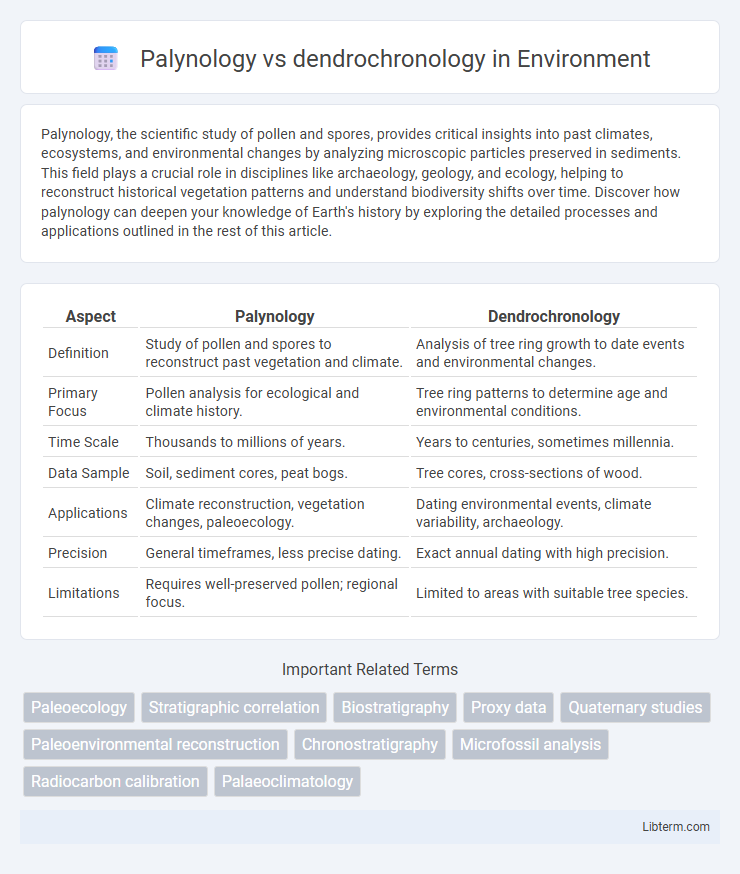Palynology, the scientific study of pollen and spores, provides critical insights into past climates, ecosystems, and environmental changes by analyzing microscopic particles preserved in sediments. This field plays a crucial role in disciplines like archaeology, geology, and ecology, helping to reconstruct historical vegetation patterns and understand biodiversity shifts over time. Discover how palynology can deepen your knowledge of Earth's history by exploring the detailed processes and applications outlined in the rest of this article.
Table of Comparison
| Aspect | Palynology | Dendrochronology |
|---|---|---|
| Definition | Study of pollen and spores to reconstruct past vegetation and climate. | Analysis of tree ring growth to date events and environmental changes. |
| Primary Focus | Pollen analysis for ecological and climate history. | Tree ring patterns to determine age and environmental conditions. |
| Time Scale | Thousands to millions of years. | Years to centuries, sometimes millennia. |
| Data Sample | Soil, sediment cores, peat bogs. | Tree cores, cross-sections of wood. |
| Applications | Climate reconstruction, vegetation changes, paleoecology. | Dating environmental events, climate variability, archaeology. |
| Precision | General timeframes, less precise dating. | Exact annual dating with high precision. |
| Limitations | Requires well-preserved pollen; regional focus. | Limited to areas with suitable tree species. |
Introduction to Palynology and Dendrochronology
Palynology examines microscopic pollen and spores to reconstruct past environments and climate changes, providing valuable data for understanding ecological shifts and human impact on vegetation. Dendrochronology analyzes tree ring patterns to date historical events and environmental conditions with annual precision, offering insights into climate variability and ecological history. Both disciplines utilize natural archives to interpret temporal environmental changes, but palynology focuses on microscopic organic particles while dendrochronology relies on growth layers in wood.
Defining Palynology: The Study of Pollen and Spores
Palynology is the scientific study of pollen and spores, which provides crucial insights into past vegetation, climate changes, and environmental conditions. By analyzing microscopic pollen grains preserved in sediments, palynologists reconstruct historical ecosystems and track ecological shifts over thousands of years. Unlike dendrochronology, which examines tree ring patterns for dating and environmental data, palynology offers detailed information on a broader range of plant species and their responses to climatic variations.
Understanding Dendrochronology: Tree-Ring Dating Explained
Dendrochronology, or tree-ring dating, involves analyzing the growth rings of trees to date events and environmental changes with annual precision. Each ring represents one year of growth, reflecting varying climatic conditions, which allows scientists to reconstruct past climates and date historical wooden artifacts accurately. In contrast, palynology studies pollen grains and spores to interpret longer-term ecological and climate shifts, making dendrochronology essential for detailed, year-by-year chronological data in environmental and archaeological research.
Core Methodologies: Palynological Techniques
Palynology primarily involves the extraction and analysis of pollen grains and spores preserved in sediment cores to reconstruct past vegetation and climate conditions. Techniques include chemical treatment to isolate microfossils, microscopic identification, and quantification of pollen assemblages. These methodologies enable detailed temporal resolution of environmental changes by correlating pollen data with stratigraphic layers.
Dendrochronological Methods: Sampling and Analysis
Dendrochronological methods involve the systematic sampling of tree rings, which requires extracting core samples using increment borers to obtain undisturbed growth records. Analysis consists of measuring ring widths and patterns through microscopic or digital imaging techniques to establish precise chronological timelines reflecting environmental conditions. This method enables high-resolution dating and climate reconstruction by correlating ring sequences from multiple trees within a region.
Applications of Palynology in Environmental Science
Palynology plays a crucial role in environmental science by analyzing pollen and spores to reconstruct past vegetation and climate changes, aiding in the study of ecosystem dynamics and biodiversity shifts. It helps track historical air quality and pollution levels by examining sediment cores, enabling assessment of human impacts on environments over time. This method complements dendrochronology, which dates tree rings for climate and ecological research, by providing broader regional vegetation and atmospheric context.
Uses of Dendrochronology in Climate and Archaeology
Dendrochronology provides precise annual records of past climate conditions by analyzing tree-ring patterns, which reveal variations in temperature, precipitation, and atmospheric composition over centuries. This method is crucial for calibrating radiocarbon dating and reconstructing archaeological timelines, enabling the dating of wooden artifacts, structures, and environmental events with high accuracy. Unlike palynology, which studies pollen grains to understand longer-term vegetation and climate changes, dendrochronology offers detailed chronological data essential for understanding short to medium-term climate fluctuations and human activity in archaeological contexts.
Key Differences Between Palynology and Dendrochronology
Palynology studies microscopic pollen and spores to reconstruct past climates and environments, while dendrochronology analyzes tree ring growth patterns to date events and assess ecological conditions. Palynology provides insight into vegetation changes over millennia, whereas dendrochronology offers annual to seasonal resolution of environmental changes. The main difference lies in their data sources: palynology relies on fossilized pollen grains, and dendrochronology depends on the physical characteristics of wood growth rings.
Advantages and Limitations of Each Approach
Palynology offers detailed insights into past vegetation and climate by analyzing pollen grains, allowing reconstruction of ecological changes over thousands of years, but its limitation lies in potential contamination and differential pollen preservation. Dendrochronology provides precise annual dating through tree ring analysis, enabling accurate climate and environmental event timelines, yet it is restricted to regions where suitable tree species grow and limited to the lifespan of those trees. Both methods complement each other by enhancing paleoclimate reconstructions despite their inherent temporal and spatial constraints.
Conclusion: Integrating Palynology and Dendrochronology for Research
Integrating palynology and dendrochronology enhances paleoenvironmental research by combining pollen analysis with tree-ring data to achieve precise dating and detailed climate reconstructions. This interdisciplinary approach enables scientists to correlate vegetation changes with climatic variations over time, improving understanding of ecosystem dynamics. The synergy between these methods offers robust insights for addressing questions in archaeology, ecology, and climate science.
Palynology Infographic

 libterm.com
libterm.com